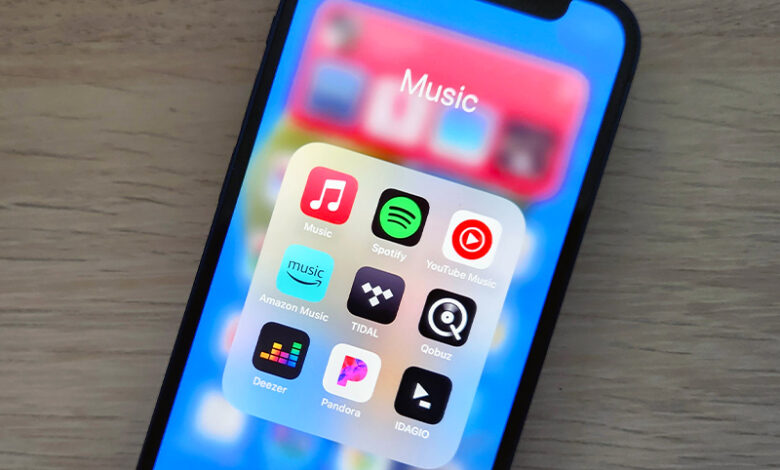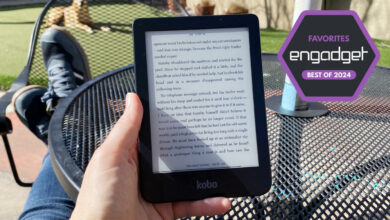The best music streaming services in 2024

Pinpointing the best music streaming service is tough. Most major players today include the same basic set of features, letting you access a giant library whenever you want across multiple devices. Because they all offer some level of personalized recommendations, the service most in tune with your tastes is usually just the one you’ve used the longest. On the flip side, they can be overwhelming to navigate, and just about all of them have recently hiked their prices. None are great about paying artists, either. But even if the broad strokes are similar across the board, there are some key differences that could make one service more attractive for you than the others. If you’re looking to start fresh with a new subscription, we’ve spent several months testing all of the big music streaming services, feeding them similar data and keeping tabs on how they adapt to our preferences. Here are the ones we like the most today.
Free tier: No | Individual plan: $11/month or $109/year | Family plan: $17/month (up to 6 members) | Student plan: $6/month | Streaming quality: Up to 24-bit/192 kHz ALAC
Apple Music combines high-quality audio and handy features with an interface that strikes a good balance between algorithmic and editorial recommendations. It offers lossless streaming for no extra charge, with its entire catalog available in CD quality (16-bit/44.1 kHz) at a minimum. This isn’t essential for most listeners, and the upgrade becomes less noticeable the higher the streaming resolution gets. But if you have a good set of wired headphones (and DAC) or a decent speaker system, it can sound richer than the compressed files used by similarly priced services like Spotify and YouTube Music.
Apple Music’s UI doesn’t diverge too far from its rivals. The home tab is littered with suggested albums and playlists based on your listening history; you can start a custom station from any one track; and all of your saved artists, albums, playlists and “favorited” songs are easy to access. There’s a dedicated station that’s personalized to your tastes, as well as a “Discovery Station” that only serves up songs you’ve never streamed. As with most music streaming services, the app’s layout can be a lot to take in, a virtual shotgun blast of icons. Also, Apple’s algorithmic recommendations aren’t quite as adventurous or scary-precise as those from Spotify, but they get the job done.
What gives Apple Music an edge is its emphasis on curation. There are regularly updated, editor-picked playlists all over the app. Many artist pages will spotlight an act’s essential works, influences and “deep cuts.” Popular albums are often accompanied by a thoughtful review or synopsis. Most notably, there’s a trio of live radio stations, with a rotation of DJ-hosted shows that spotlight new records and artist interviews. To be clear, Apple Music is still heavy on algorithmic content, but its human touch is more apparent than many of its peers. Rather than feeling like you’re totally giving into The Machine, you get the sense there are actual people guiding you to music you may (or may not!) like.
Beyond that, this is one of the few options that lets you import your own music files, which is a boon for those holding onto big iTunes libraries. As you’d expect, it’s also tightly wound with other Apple products: You can use Siri to start up a playlist, favorite songs from an iPhone’s Control Center and stream with minimal fuss on an Apple TV or HomePod.
There are still drawbacks. While Apple Music works on every major platform, it’ll inevitably feel smoothest on Apple’s own devices. Apple has made a huge push into spatial audio, but the effect often sounds unnatural with music that isn’t produced for it. There’s no free tier, either, nor are there podcasts. Some, including yours truly, would consider that last point a positive; it keeps the app from feeling even more cluttered. But if you like having all of your audio content in one place, our next recommendation might be a better fit.
- Impressive blend of curated content and personalized recommendations
- All music available in CD quality or higher
- Local file support
- Works best with Apple devices
- Spatial audio can sound unnatural
- No free tier
Free tier: Yes | Individual plan: $11/month | Duo plan: $15/month (2 members) | Family plan: $17/month (up to 6 members) | Student plan: $6/month | Streaming quality: Up to 320kbps Ogg Vorbis
Spotify leans harder on “the algorithm” than Apple Music, but its recommendation engine is particularly adept at suggesting music you’ll probably like. It’s especially impressive at making playlists. “Discover Weekly” fully deserves its reputation for digging up tracks you’ve never heard that still align with your tastes. A malleable set of “Daily Mixes” blend new and familiar tracks by tone as much as genre. A regularly updated “daylist” morphs in line with the kind of music you’ve been listening to at different points in the day. What feels like a billion other mixes based on artists, decades, moods and more nebulous concepts (“escapism,” “cottagecore,” “Ethiopian jazz”) are often on point as well. Simply following the engine down its rabbit holes will usually lead you to something new and enjoyable.
There are still a ton of manually curated playlists to peruse outside of that. Updated mixes like “Rap Caviar,” “New Music Friday” and “Viva Latino” may not be personalized for you, but they are clearly put together by knowledgeable people in tune with current trends. There’s a human touch here, it’s just buried deeper than it is on Apple Music. Which one you’ll prefer depends on how willing you are to let an algorithm lead the way.
Unless you want podcasts and audiobooks, that is. While Apple boots those into separate apps, Spotify goes all-in on non-music content. Several popular podcasts are exclusive to the service, and paid subscribers get 15 hours of audiobook streaming each month for no extra cost. Spotify also has a relatively generous free tier: It has ads and strictly limits your ability to pick songs on-demand but still provides access to much of the library. For many acts, you can view tour dates and buy tickets or merch right from the app. There’s a comprehensive set of social sharing features as well: You can discover and collaborate on other people’s playlists, follow friends and easily share your own lists. A Spotify Connect feature makes it a breeze to move from one device to another without losing your place. Plus, as the most popular music service, it has an app on almost every major platform.
Our main gripes with Spotify come down to its interface. It starts off fine enough but gets messier the more you scroll. The desktop app has a handy sidebar that provides fast access to your library, while the mobile app has a bunch of playlists, podcasts and recent listens to jump into right at the top. After that, there are rows of suggested podcasts and audiobooks mixed with the music, including many you may not have expressed an interest in. The way Spotify nudges you toward aesthetically similar content is a great way to discover three-minute songs, but it’s more obnoxious with hours-long shows. Just because we like the Engadget Podcast, for instance, doesn’t mean we want to spend 80 more minutes listening to other, potentially more aggravating people talk about tech.
Past those, the mobile app becomes a string of big, auto-playing, TikTok-style suggestion cards. These also pop up if you sort the home tab by music, podcasts or audiobooks. They look slick, but scrolling through a feed of giant cards, one suggestion at a time, isn’t an efficient way to find something interesting. At least some of these appear to be sponsored as well. When you sort by “music,” the first card you see is an algorithmic “AI DJ” tool that’s technically impressive but sometimes makes jarring leaps between genres. We usually get the most out of Spotify when ignoring the home tab and diving into playlists through our library or search instead.
There’s also no lossless streaming, despite Spotify announcing a CD-quality “HiFi” tier more than three years ago. Recent speculation suggests a $20-per-month “Supremium” tier could arrive soon, but that’d be a big price jump over Apple and other competitors. Though you can play local files stored on your device through the Spotify app, you can’t import them into your library across devices as neatly as you can with Apple Music. And while no music streamer is truly great about compensating artists (Apple included), Spotify has a particularly horrible reputation for low payouts. Its ad-based tier, while convenient for consumers, exacerbates that.
- Superb recommendation engine with tons of fun and inventive playlists
- Widely available and easy to use across platforms
- Podcasts and audiobooks
- Free tier
- No lossless streaming
- App often feels cluttered
- Ad-based tier means lower payments to artists
Free tier: Yes | Individual plan: $11/month or $110/year; also available as part of YouTube Premium subscription for $14/month or $140/year | Family plan: $17/month (up to 6 members) | Student plan: $5.49/month | Streaming quality: Up to 256kbps AAC & OPUS
If you’re really into YouTube, you’ll like YouTube Music. It comes included with a YouTube Premium subscription, which removes ads from the video site, allows for offline downloads and enables background playback for $14 a month. Those are significant upgrades on their own, plus there’s a full Spotify competitor on top. For those who already spend a ton of time on YouTube, Google’s music service may be the best value by default.
Even without those perks, YouTube Music benefits from close ties to its sister site. YouTube is home to a mountain of creative works that just aren’t available on standard music services, from obscure soundtracks and rare live performances to monstrous Neil Cicierega mashups and Radiohead remixes made entirely out of Super Mario 64 sounds. With this service, you can search through those, add them to playlists and listen to them alongside more traditional releases. (Though they won’t integrate into your library as neatly.) If you sign up with the same account, music you’ve liked on YouTube will show up right away and help inform YouTube Music’s recommendations. You also get the same enormous selection of music videos, which you can access with a single tap.
As with Apple Music, YouTube Music lets you upload your own music files. It’s also one of the better options when it comes to surfacing new artists. A constantly updated “Discover Mix” playlist works similarly to Spotify’s “Discover Weekly,” and we’ve discovered many lesser-known acts through the app’s algorithmic track radios and community-based playlists.
That said, the integration with YouTube is really the thing here; without it, there isn’t much reason to choose YouTube Music over Apple Music or Spotify. It lacks lossless streaming, and its home tab is as much of a hodgepodge of disparate elements as any other service. Its ability to pull music you’ve liked on YouTube, while convenient, is often sloppy in its execution: One of our saved playlists, for instance, was a video game walkthrough that mostly isn’t viewable through the app anyway. In general, the UI is especially loaded with algorithmic suggestions, with few of the little editorial touches you’d find in Apple Music.
There are podcasts, technically, but right now the selection mainly consists of YouTube videos that are marked as podcast content. Many shows still appear as promised, but other feeds consist only of brief clips rather than full episodes, while some are missing entirely. You can add missing podcasts to your library via RSS, but that’s an extra step Spotify doesn’t force you to take. We’d also be remiss not to mention Google’s long history of killing its own products, including this service’s predecessor. Nevertheless, the company seems committed to YouTube Music today, and it has improved the service over time.
- Includes a wealth of rare and interesting music that isn’t available on other services
- Available with YouTube Premium subscription
- Strong music discovery tools
- Local file support
- No lossless streaming
- Podcast integration is messy
- UI can feel overwhelming at times
Free tier: No | Individual plan: $13/month or $130/year (Studio); $180/year (Sublime) | Duo plan: $18/month or $180/year (Studio); $270/year (Sublime) (2 members) | Family plan: $22/month or $216/year (Studio); $350/year (Sublime) (up to 6 members) | Streaming quality: Up to 24-bit/192 kHz FLAC
Qobuz is worth a look for audiophiles who’d like a more curated music service and don’t want to funnel more cash into a tech giant like Apple or Google. Even more than Apple Music, it comes off like the streaming equivalent of a friendly music nerd. The top of the app greets you with a handpicked selection of recent albums. Tons of records, new and old, come with liner-notes-like reviews. A “Magazine” tab offers a stream of fun articles; as we write this, recent features include a Wu-Tang Clan retrospective, a rundown of essential Kate Bush songs and a regular “Album of the Week” write-up. Qobuz emphasizes albums more than playlists overall; it wants you to engage with an artist’s complete work, not just in bits and pieces as encouraged by algorithms. Yet the playlists it does have are diverse and cleverly crafted.
Like Apple Music, Qobuz includes lossless streaming for no extra cost, its FLAC files reaching up to 24-bit/192 kHz. It also lets you purchase albums outright in CD or Hi-Res quality. If you subscribe to its upper “Sublime” tier, you can get those at a discount. It all speaks to a service with a record-store mindset: Its recommendations mostly come from real people, its streams are high quality, and it doesn’t slavishly tailor itself to your listening history. Past reports suggest it’s one of the better-paying services for artists, too, something its digital album shop should only help.
Still, this sort of anti-Spotify approach has its shortcomings. When it does have to algorithmically recommend music — through a track radio, for instance, or its personalized “Weekly Q” playlist — its selections just don’t flow as naturally or coherently as the major players. Its search tool can be spotty, too, and it’s not as receptive to sharing on social platforms. While it has a huge library with more than 100 million tracks, it tends to not spotlight Top 40 hits as strongly as Spotify or Apple Music, particularly when it comes to hip-hop and pop. (Though this may be a positive for some people.) There are no podcasts or audiobooks, either, plus it costs $2 more per month than our other top picks.
- Thoughtful curation and editorial content
- Lossless streaming included in base tier
- Cleanly designed app on mobile and desktop
- Offers digital store for buying music
- Recommendation algorithm isn’t as strong as peers
- Costs more than rival services
- Not ideal for keeping up with popular music
Other notable music streaming services
Tidal
Tidal offers lossless streaming, a free tier and a hefty dose of curated recommendations. It also compensates artists better than most of its rivals. It’s a great choice for audiophiles who want a service that’s largely focused on modern pop music. However, its mobile and desktop apps aren’t quite as smooth as those from Apple Music, its algorithmic recommendations generally fall short of Spotify and it doesn’t lean as hard into editorial content as Qobuz. If you think you need Hi-Res quality, you have to pay $20 per month, which is much higher than Apple Music or Qobuz. You can still get CD-quality streams for $11 a month, though.
Amazon Music Unlimited
Amazon Music Unlimited supports podcasts and lossless streaming, plus it costs a dollar less than most music services if you subscribe to Amazon Prime. Naturally, it also works great with Amazon’s fleet of Alexa devices. Its interface is a bit sloppier than those of our main picks, though, with weaker discovery features than Spotify or Apple Music and a relatively aggressive approach to promoting podcasts you may not care about.
Deezer
Deezer has an attractive app, CD-quality streaming, a competitive library, a free tier and the option to upload local MP3 files. It also gives quick access to several live radio stations from around the globe, which is great. There’s really nothing wrong with it, so if you’re smitten with the interface and like those features, it should serve you well. But it costs a dollar more than Apple Music or Spotify each month, and its playlists and discovery tools generally aren’t as rich. It lacks Hi-Res streaming as well.
Pandora Premium
Pandora is superb at surfacing music you’ll probably like, so its free or “Plus” tiers will work great if all you need is a simple, personalized internet radio. If you want music on-demand, though, you need a “Premium” subscription, which costs $10 a month. That’s cheaper than our main picks, but the app is much less feature-rich, and it has the most compressed streaming quality of any service we tested, maxing at 192kbps.
Source link





